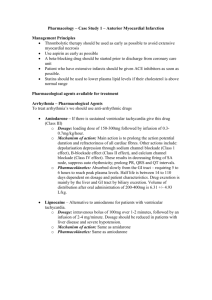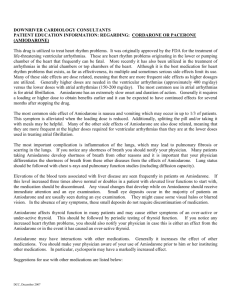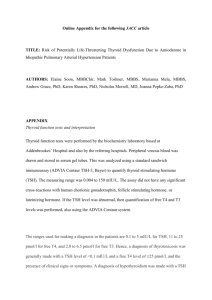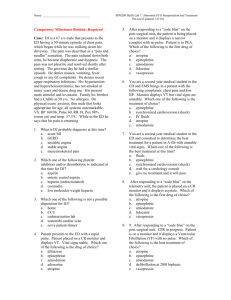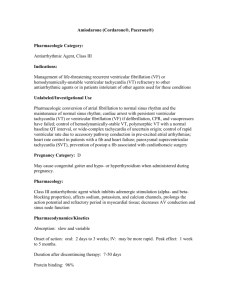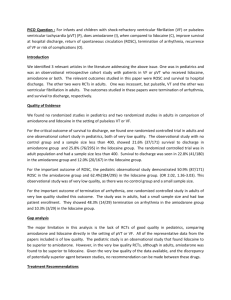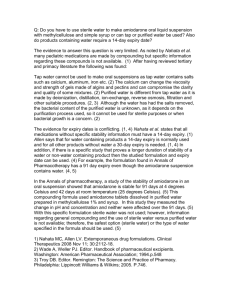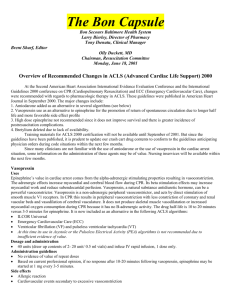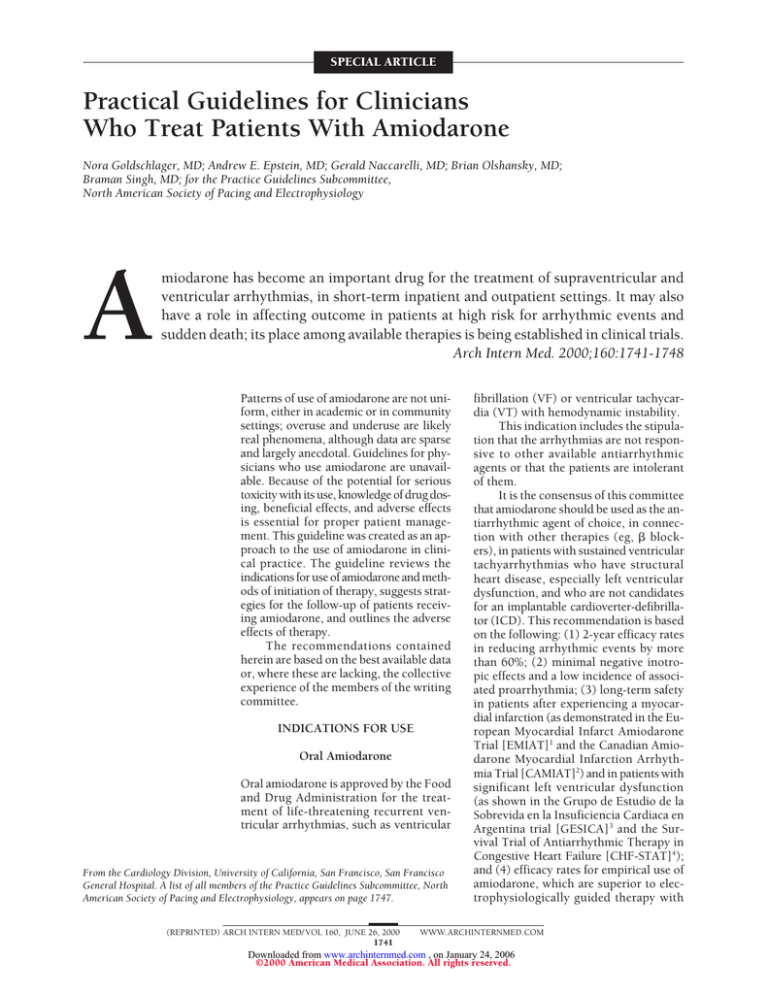
SPECIAL ARTICLE
Practical Guidelines for Clinicians
Who Treat Patients With Amiodarone
Nora Goldschlager, MD; Andrew E. Epstein, MD; Gerald Naccarelli, MD; Brian Olshansky, MD;
Braman Singh, MD; for the Practice Guidelines Subcommittee,
North American Society of Pacing and Electrophysiology
A
miodarone has become an important drug for the treatment of supraventricular and
ventricular arrhythmias, in short-term inpatient and outpatient settings. It may also
have a role in affecting outcome in patients at high risk for arrhythmic events and
sudden death; its place among available therapies is being established in clinical trials.
Arch Intern Med. 2000;160:1741-1748
Patterns of use of amiodarone are not uniform, either in academic or in community
settings; overuse and underuse are likely
real phenomena, although data are sparse
and largely anecdotal. Guidelines for physicians who use amiodarone are unavailable. Because of the potential for serious
toxicity with its use, knowledge of drug dosing, beneficial effects, and adverse effects
is essential for proper patient management. This guideline was created as an approach to the use of amiodarone in clinical practice. The guideline reviews the
indications for use of amiodarone and methods of initiation of therapy, suggests strategies for the follow-up of patients receiving amiodarone, and outlines the adverse
effects of therapy.
The recommendations contained
herein are based on the best available data
or, where these are lacking, the collective
experience of the members of the writing
committee.
INDICATIONS FOR USE
Oral Amiodarone
Oral amiodarone is approved by the Food
and Drug Administration for the treatment of life-threatening recurrent ventricular arrhythmias, such as ventricular
From the Cardiology Division, University of California, San Francisco, San Francisco
General Hospital. A list of all members of the Practice Guidelines Subcommittee, North
American Society of Pacing and Electrophysiology, appears on page 1747.
(REPRINTED) ARCH INTERN MED/ VOL 160, JUNE 26, 2000
1741
fibrillation (VF) or ventricular tachycardia (VT) with hemodynamic instability.
This indication includes the stipulation that the arrhythmias are not responsive to other available antiarrhythmic
agents or that the patients are intolerant
of them.
It is the consensus of this committee
that amiodarone should be used as the antiarrhythmic agent of choice, in connection with other therapies (eg, b blockers), in patients with sustained ventricular
tachyarrhythmias who have structural
heart disease, especially left ventricular
dysfunction, and who are not candidates
for an implantable cardioverter-defibrillator (ICD). This recommendation is based
on the following: (1) 2-year efficacy rates
in reducing arrhythmic events by more
than 60%; (2) minimal negative inotropic effects and a low incidence of associated proarrhythmia; (3) long-term safety
in patients after experiencing a myocardial infarction (as demonstrated in the European Myocardial Infarct Amiodarone
Trial [EMIAT]1 and the Canadian Amiodarone Myocardial Infarction Arrhythmia Trial [CAMIAT]2) and in patients with
significant left ventricular dysfunction
(as shown in the Grupo de Estudio de la
Sobrevida en la Insuficiencia Cardiaca en
Argentina trial [GESICA]3 and the Survival Trial of Antiarrhythmic Therapy in
Congestive Heart Failure [CHF-STAT]4);
and (4) efficacy rates for empirical use of
amiodarone, which are superior to electrophysiologically guided therapy with
WWW.ARCHINTERNMED.COM
Downloaded from www.archinternmed.com , on January 24, 2006
©2000 American Medical Association. All rights reserved.
class 1 antiarrhythmic agents (shown
in the Cardiac Arrest in Seattle: Conventional vs Amiodarone Drug
Evaluation [CASCADE] trial5).
Several prospective trials (Antiarrhythmics Versus Implantable
Defibrillators [AVID],6 Cardiac Arrest Study Hamburg [CASH],7 and
Canadian Implantable Defibrillator
Study [CIDS]8) have demonstrated
that an ICD is superior to empirical
amiodarone therapy in preventing
sudden cardiac death. Moreover, the
AVID trial6 showed improvement in
overall survival. Of patients who have
ICDs, 30% to 70% require concomitant antiarrhythmic treatment. Amiodarone is effective in slowing the rate
of VT, as tested in the electrophysiology laboratory; this effect appears
to be predictive of a better outcome.
Although amiodarone can increase
the defibrillation threshold, necessitating ICD retesting once the drug has
been initiated, it may be useful for patients refractory to, or who are not
candidates for, sotalol hydrochloride or other b-blocker therapy. In
cases of extremely elderly or critically ill patients in whom an ICD
might not be appropriate, amiodarone should be used as first-line
therapy in hemodynamically unstable sustained VT. The role of electrophysiologic testing in patients receiving amiodarone is controversial,
and remains to be clarified.
Although patients with nonsustained VT and left ventricular
dysfunction are recognized to be at
increased risk for sudden cardiac
death, treatment of these arrhythmias is controversial. In the CHFSTAT4 and the GESICA trial,3 use
of amiodarone had neutral overall
effects on mortality in patients
with ischemic cardiomyopathy and
improved survival in those with
nonischemic cardiomyopathy. Based
on these studies, the consensus of
this committee is that it is reasonable to use amiodarone in patients
with significant left ventricular dysfunction and nonsustained VT that
is symptomatic or concerning
enough to warrant treatment.
Although not Food and Drug
Administration–approved for use in
atrial fibrillation, oral amiodarone is
effective in controlling ventricular
rate in atrial fibrillation and in maintaining sinus rhythm in more than
60% of patients during a 2- to 3-year
period. Given its safety profile,
especially in patients after a myocardial infarction and in patients
with heart failure, amiodarone
should be considered to be one of
the drugs of choice in maintaining
sinus rhythm in patients with paroxysmal atrial fibrillation. In patients without structural heart disease, amiodarone should be used if
their atrial fibrillation is refractory
to other agents or if the patient is
intolerant of them.
Although preoperative oral
amiodarone loading has been reported to significantly reduce the incidence of atrial fibrillation after aortocoronary bypass surgery, 9 this
management strategy has not been
widely accepted because of the widespread use of b blockers, logistical
preoperative loading dose issues, and
cost.
Intravenous (IV) Amiodarone
Intravenous amiodarone has been
approved by the Food and Drug Administration for the treatment and
prophylaxis of recurrent VF and hemodynamically unstable VT in patients refractory to other therapy.
This indication is supported by 2
prospective, randomized, parallel,
dose-response studies10,11 that demonstrated a favorable trend toward
a decrease in VT or VF events per
hour and time to the first VT or VF
event. Significantly fewer supplemental infusions were required in
patients receiving IV amiodarone,
1000 mg/d, compared with those receiving smaller doses.
Intravenous amiodarone was
reported to have comparable efficacy to IV bretylium tosylate in one
study11; the mortality rate was not
affected. Intravenous amiodarone is
also approved to treat patients with
VT or VF who are candidates for oral
amiodarone but are transiently unable to take the oral preparation.
In critically ill patients who develop atrial fibrillation with rapid
ventricular response, IV amiodarone has been found to be effective
in controlling the ventricular rate
through its short-term calcium channel-blocking and sympatholytic effects, although it is not approved by
the Food and Drug Administration
(REPRINTED) ARCH INTERN MED/ VOL 160, JUNE 26, 2000
1742
for this use. However, since acutely
administered IV amiodarone has
little effect on atrial refractory periods, placebo-controlled trials12 have
demonstrated no increase in efficacy in converting atrial fibrillation to sinus rhythm. One recent
study suggests that IV amiodarone
may minimize the occurrence of
atrial fibrillation in patients who
have undergone an aortocoronary
bypass.13 Further trials should verify
these findings before routine prophylactic use of amiodarone can be
recommended.
DRUG DOSING
Amiodarone appears to have an unparalleled efficacy, a broad spectrum of antiarrhythmic action, and
a complex array of adverse effects
when used as an antiarrhythmic and
antifibrillatory compound. Some
knowledge of its pharmacodynamics, electropharmacologic features,
and pharmacokinetics is essential as
a basis for initiating therapy in the
hospital or in the outpatient setting
and for its safe and effective use
during long-term therapy.
The complexity of the electropharmacologic profile of amiodarone is striking.14 The drug lengthens repolarization, but it is not just
another class 3 antiarrhythmic agent;
it exhibits all 4 electrophysiologic
classes of action. Its sodium channel–blocking action is seen largely
at rapid heart rates but is not associated with the proarrhythmic effect typical of class 1 agents. Unlike
the class 1 drugs, it neither increases mortality nor depresses ventricular function; in fact, it increases left ventricular ejection
fraction in patients with heart failure. Its class 2 or antiadrenergic actions resemble those of b blockers
but without their adverse effects, in
part because its b-blocking activity
is relatively weak. It differs from all
other class 3 agents in (1) rarely
producing torsade de pointes
despite markedly lengthening the
QT interval and (2) maintaining its
efficacy at rapid heart rates. The
compound can be administered
“empirically,” without electrophysiologic testing or Holter-guided
evaluation, which simplifies its use
in clinical practice.15
WWW.ARCHINTERNMED.COM
Downloaded from www.archinternmed.com , on January 24, 2006
©2000 American Medical Association. All rights reserved.
Amiodarone is highly lipophilic, with a long elimination halflife that is highly variable among patients (35-110 days). It may require
months for blood levels to reach
steady state, and levels are not correlated with clinical effects. Thus,
caution must be used in assessing generic versions of the compound exclusively based on drug bioequivalence. The oral bioavailability of
amiodarone averages 30% to 50%,
and excretion via the kidneys is
minimal; it can, therefore, be administered safely in anephric patients. The amiodarone dose does
not need to be reduced in patients
with renal disease; the drug and its
metabolite are not dialyzable. Amiodarone is metabolized in the liver,
its major metabolite being desethylamiodarone, which is pharmacologically active and has a longer
elimination half-life than that of the
parent compound. Because they are
lipophilic, amiodarone and its metabolites are extensively accumulated in the liver, lung, fat, skin, and
other tissues. The onset of action after IV drug administration occurs
within several hours, whereas after
oral administration the onset of action may require 2 to 3 days, depending on the dosing regimen.
There is a reasonable linearity between plasma drug concentration
and dose of amiodarone, and the
plasma level of the drug in patients
successfully treated with amiodarone usually ranges between 1.5 and
2.5 µg/mL; desethylamiodarone levels also increase as a function of time
and reach a level either comparable
to or in excess of that of the parent
compound. However, there is a poor
correlation between plasma levels
and either the therapeutic or toxic
effects of the drug. As a result, established pharmacokinetic principles may not provide a reliable basis for predicting the attainment of
steady-state therapeutic effects of the
drug.
There are few absolute contraindications to the use of amiodarone. The drug is best avoided in patients with active thyrotoxicosis,
cirrhosis of the liver or other forms
of advanced liver disease, and severe pulmonary disease (especially
extensive fibrosis) and in patients
with a history of major adverse ef-
fects due to previous exposure to the
drug.
Oral Drug Initiation
Clinical experience with amiodarone has led to various drug-dosing
considerations that are of practical
importance, whether the drug is being used to maintain sinus rhythm in
paroxysmal atrial flutter and fibrillation, to treat ventricular arrhythmias as a principal mode of therapy,
or as adjunctive therapy in patients
with ICDs. The most significant principle of therapy is to use the lowest
dose of the drug that will produce
the desired therapeutic effects to reduce the risk of intolerable or potentially serious adverse effects. Although high-dose loading regimens
have been used, advantages over
lower-dose loading regimens have
not been demonstrated,16 although
they may be well tolerated.17 The
relative merits of IV loading in place
of these high-dose oral regimens is
unknown.
An initial loading dosage, in patients with ventricular arrhythmias, of 800 to 1600 mg/d (usually
in divided doses) for up to 2 to 3
weeks is reasonable. At this stage, the
dose may be reduced to 400 to 600
mg/d, since such a regimen is usually adequate to produce close to a
steady state in patients with ventricular arrhythmias. For many patients, this dose will be sufficient for
long-term maintenance during the
first year. In some patients, the dose
may be reduced even further (to 200300 mg/d). Dose reduction may be
necessary earlier in the event of adverse effects, especially constipation and central nervous system
symptoms. Lower loading and maintenance doses are preferable in
women and in all patients with a low
body weight.18 Reducing the dose to
200 mg/d in patients being treated
for ventricular arrhythmias may result in a high risk of arrhythmia recurrence, especially as a function of
time. In such situations, the addition of a second antiarrhythmic drug,
in particular a b blocker, may be
helpful. Alternatively, an ICD may
be implanted if an increase in amiodarone dose is deemed undesirable
or is not well tolerated. Lower doses
of amiodarone in conjunction with
(REPRINTED) ARCH INTERN MED/ VOL 160, JUNE 26, 2000
1743
an ICD can minimize the risks of arrhythmia recurrence and adverse
drug effects, while the ICD offers
protection against arrhythmic death.
For the initial control of VT and fibrillation, therapy is always initiated in the hospital except in patients who already have an ICD, in
whom amiodarone therapy can be
initiated on an outpatient basis.
In the management of patients
with atrial fibrillation, loading and
maintenance doses can be much
lower than those for life-threatening ventricular arrhythmias and
therapy can be initiated safely in the
outpatient clinic. Caution must be
exercised in patients in whom there
is a suspicion of sinus or AV node
dysfunction, in whom druginduced bradycardia may develop.
Various regimens have been recommended. A reasonable loading dosage is 600 to 800 mg/d (in 2 divided doses) for 2 to 4 weeks;
thereafter, the dose can be reduced
to 400 mg/d, and further reduced to
100 to 300 mg/d at 3 to 6 months,
depending on clinical efficacy and
the development of adverse effects.
The usual maintenance dose for
atrial fibrillation is 200 mg/d, although in the event of breakthrough arrhythmias, short periods of higher doses may be required;
higher maintenance doses may be required in some patients. In some
situations, satisfactory clinical efficacy can be obtained with amiodarone, 200 mg/d, given 5 days a week,
especially in women with a low body
mass index. During loading and
maintenance dosing, drug interactions with digoxin and warfarin sodium must be recognized, since
these drug dosages will have to be
reduced accordingly.
IV Dosing
There appears to be substantial individual variation in response time
during the initiation of IV amiodarone therapy.19 Consequently, dosing recommendations are derived
from clinical trial experience and
provide guidelines only; close patient observation and dose adjustments are essential for optimum benefit without adverse effects. For
example, hypotension and other adverse cardiac effects that may be seen
WWW.ARCHINTERNMED.COM
Downloaded from www.archinternmed.com , on January 24, 2006
©2000 American Medical Association. All rights reserved.
during initial rapid infusion may improve significantly with a decrease
in the rate of infusion.20-22 In contrast, supplemental IV boluses are
frequently needed for patients with
recurrent arrhythmias during the
early phases of dosing. The recommended initial IV loading dose10,22 is
150 mg administered for 10 minutes, followed by an intermediate infusion of 1 mg/min for 6 hours and
0.5 mg/min thereafter. Supplemental boluses of 150 mg may be given
for 10 to 30 minutes for recurrent arrhythmias, but because hypotension
occurs more frequently at daily doses
greater than 2000 mg, no more than
6 to 8 supplemental boluses in any 24hour period may be possible. Plasma
drug levels are not routinely used because they are high and uninterpretable in the early phases of therapy and
because there is a wide variation in
“effective concentrations” of parent
compound and metabolite. When
given intravenously, amiodarone
should be mixed in a 5% dextrose solution and should be infused with a
volumetric pump. If used in high concentrations (.2 mg/mL), it must be
delivered through a central vein
because it can cause peripheral
phlebitis (in ,3% of patients).
Amiodarone does not need light
protection but is physically incompatible with several drugs, such as
heparin, with which it is frequently
used. In multicenter trials, the median duration of IV amiodarone
therapy was 4 days, but there was
wide variation. Patients who could
not take oral medication were treated
for 3 to 6 weeks without difficulty.
Transition to Oral Therapy
The bioavailability of oral vs IV
amiodarone varies from 30% to 70%.
Bioavailability appears to be lower
in elderly patients and in those with
cardiopulmonary disease. Recommendations regarding the transition from IV to oral therapy take into
account these properties, in addition to the fact that there may be a
delay of 4 to 5 hours between ingestion of the oral drug and an increase in the plasma level. Generally, the longer the patient has been
receiving IV therapy, the less the
need for the customary large oral
loading doses.
More than 90% of the patients
who received IV amiodarone in
controlled clinical trials eventually
underwent oral therapy, principally
because they had significant arrhythmias that were not due to an easily
reversible cause. When the drug is
used in clinical situations in which
the underlying condition can be remedied, such as in patients with an
acute myocardial infarction who have
undergone successful revascularization, the rate of conversion to oral
therapy will probably decline. Patients who have been receiving IV
therapy for more than 2 to 3 weeks
can be started safely on maintenance doses of oral amiodarone (300400 mg/d). Those treated for 1 week
or less should probably receive the
usual oral loading regimen of 800 to
1200 mg/d, whereas an intermediate dose of 400 to 800 mg/d might be
suitable for patients who fall in between these time frames. If there is
concern about gastrointestinal tract
function, both oral and IV therapy
should be maintained for a few days.
These recommendations are empirical, based on the usual target total
drug dose for in-hospital drug loading, and are not based on careful
pharmacological trials.
Occasionally, a patient who is receiving long-term therapy temporarily cannot take oral medication. Because amiodarone is slowly eliminated
from the body, cessation of therapy
for a few days is of little consequence, but patients should have electrocardiographic monitoring within
5 to 7 days because of the drug’s biphasic elimination profile. If oral
therapy cannot be started after that
time, or if there is doubt about adequate gastrointestinal tract absorption, IV therapy can be substituted.
A loading dose is not necessary; based
on the known range of its bioavailability, infusion of 30% to 70% of the
daily oral dose will suffice.
Intravenous amiodarone has
been used for the treatment of patients who have received long-term
oral therapy but who have recurrent arrhythmias. Under these circumstances, it should be assumed
that the patient has insufficient myocardial tissue drug concentrations,
especially if the QT interval is not
prolonged. It is customary in these
situations to use the recommended
(REPRINTED) ARCH INTERN MED/ VOL 160, JUNE 26, 2000
1744
loading and maintenance doses of
the IV formulation until the arrhythmia is suppressed, and then to prescribe oral therapy.
Assessment of Efficacy
After a patient has received loading
doses of either oral or IV amiodarone, the question may arise as to the
need for an evaluation to confirm
clinical efficacy before hospital discharge. Arrhythmia suppression
with an IV antiarrhythmic drug does
not necessarily predict the efficacy
of its oral formulation. Moreover, the
sporadic nature of recurrent VT or
VF and paroxysmal atrial arrhythmias can make short-term suppression of arrhythmia difficult to interpret vis-à-vis long-term suppression.
Options include either monitoring
to determine whether, for example, repetitive forms, especially
nonsustained VT, have been suppressed or performing electrophysiologic testing. There are no definitive data to prove the value of either
method. Patients with paroxysmal
atrial arrhythmias need not undergo such testing.
FOLLOW-UP
Appropriate long-term management of patients taking amiodarone is essential. Without proper assessment of the patient by the
physician, the risk-benefit ratio of
using amiodarone may weigh in favor of risk rather than benefit. Adverse effects are common, with a
prevalence as high as 15% in the first
year of use and up to 50% during
long-term use (Table 1),20-22 indicating a cumulative adverse effect
profile. Fortunately, many of these
adverse effects are manageable and
the need to stop amiodarone therapy
due to serious adverse reactions is
relatively low, occurring in less than
20% of patients. Specific evaluation for adverse effects appears
to identify the development and
prevent the progression of serious
adverse effects. Accelerated follow-up is required when there is
development of an adverse effect.
Optimizing therapy with amiodarone entails using the lowest
effective dose to minimize adverse
effects.
WWW.ARCHINTERNMED.COM
Downloaded from www.archinternmed.com , on January 24, 2006
©2000 American Medical Association. All rights reserved.
Table 1. Adverse Reactions to Amiodarone
Reaction
Incidence, %
Pulmonary
1-20
Gastrointestinal tract
Thyroid
1-22
,3
Skin
Central nervous system
Ocular
Heart
Genitourinary
30
15-50
,3
,10
25-75
3-30
,5
1
.90
5
,1
,1
Diagnosis*
Cough, especially with local or diffuse infiltrates
on chest x-ray film, suggesting interstitial
pneumonitis; and decrease in DLCO
from baseline
Nausea, anorexia, and constipation
AST or ALT level greater than 2 times normal
Hepatitis and cirrhosis
Hypothyroidism
Hyperthyroidism
Blue discoloration
Photosensitivity
Ataxia, paresthesias, peripheral polyneuropathy,
sleep disturbance, impaired memory,
and tremor
Halo vision, especially at night
Optic neuritis
Photophobia, visual blurring, and microdeposits
Bradycardia and AV block
Proarrhythmia
Epididymitis and erectile dysfunction
Management
Usually discontinue drug; corticosteroids may be considered;
occasionally, can continue drug if levels high and
abnormalities resolve; rarely, continue amiodarone
with corticosteroid if no other option
Symptoms may decrease with decrease in dose
If hepatitis considered, exclude other causes
Consider discontinuation, biopsy, or both to determine
whether cirrhosis is present
Thyroxine
Corticosteroids, propylthiouracil or methimazole, and
may need thyroidectomy
Reassurance and sunblock
Sunblock
Often dose dependent, and improve or resolve with dose
adjustment
Corneal deposits the norm; if optic neuritis occurs, discontinue
May need permanent cardiac pacing
May need to discontinue the drug
Pain may resolve spontaneously
*DLCO indicates diffusion capacity of carbon monoxide; AST, aspartate aminotransferase; and ALT, alanine aminotransferase.
The time to steady state on a
given dose of a drug may exceed 6
months. Likewise, it may take more
than 6 months before an adverse
drug effect is reversed.
Issues of importance in follow-up are the continued assessment of drug efficacy, titration of
drug dose after achieving a steady
state, evaluation of adverse and toxic
effects, appropriate management of
toxic effects, and attention to important drug-drug and drug-device
interactions.
When amiodarone first became available in the United States,
because of its potential toxicity, electrophysiologists were the only physicians who prescribed the drug. As
the drug gained popularity, its use by
physicians who do not specialize in
arrhythmia management increased.
An electrophysiologist is not required for routine long-term follow-up if the treating physician has
knowledge of drug doses and adverse effects of amiodarone and has
demonstrated expertise in the follow-up of patients taking amiodarone. Whereas such physicians have
generally been cardiologists, some internists and family practitioners may
have enough experience with, and
comfort using, the drug to provide
follow-up evaluation. We believe that
nonphysician personnel should not
provide the follow-up support of patients taking amiodarone.
Routine evaluation requires an
office visit to assess new symptoms
possibly related to the drug (Table
1), recurrence of arrhythmias, the
need for upward or downward drug
titration, laboratory testing, and
changes in drug therapy. Follow-up should be most intensive initially, especially if dose titration is
expected to be necessary or if outpatient oral dose loading is under
way. Initial assessment should occur every 3 months for the first year
to assess arrhythmia stability and adverse effects, after which follow-up
visits should occur every 6 months.
Adverse effects are partly dose related, increasing with time of exposure. Some adverse effects (neurologic and gastrointestinal tract
toxicity) are clearly dose related, and
often occur in the first phases of
amiodarone loading. Visual changes
(“haloes” around lights) are generally, but not always, dose related. Serious long-term toxicity (the most
worrisome of which is pulmonary
toxicity) appears related in part to
drug dosing. It is arguable whether
pulmonary toxicity occurs to a greater
degree in patients who have underlying pulmonary disease, such as obstructive pulmonary disease. It can be
difficult to distinguish the progres-
(REPRINTED) ARCH INTERN MED/ VOL 160, JUNE 26, 2000
1745
sion of this underlying disease, however, from the additive effects of
amiodarone. Nevertheless, in patients who have underlying pulmonary disease, more careful follow-up is required, even if the patient
is taking a low dose (mean dose,
,300 mg).23,24
To our knowledge, there are few
data to document a better outcome
with more careful and frequent follow-up, despite the intuitive prudence of this approach. However,
early recognition of organ toxicity will
expedite early corrective management. The treating physician should
educate the patient regarding drug interactions and potential toxicities, and
document these discussions in the
medical record.
Specific Information
to Be Acquired During
Follow-up Visits
History. Complaints of fatigue (suggesting bradycardia, AV block, or hypothyroidism), dyspnea or cough
(suggesting pulmonary toxicity),
palpitations (suggesting hyperthyroidism or recurrence of arrhythmias), syncope, visual changes (including loss of vision), skin changes
(including photosensitivity), weight
change (suggesting hypothyroidism or hyperthyroidism), paresthe-
WWW.ARCHINTERNMED.COM
Downloaded from www.archinternmed.com , on January 24, 2006
©2000 American Medical Association. All rights reserved.
Table 2. Routine Laboratory Testing in Patients Receiving Amiodarone*
Type of Test†
Time When Test Is Performed
Liver function tests
Thyroid function tests (T4 and TSH)
Serum creatinine and electrolytes
Chest x-ray film
Ophthalmologic evaluation
Pulmonary function tests
(including DLCO)
Baseline and every 6 mo
Baseline and every 6 mo
Baseline and as indicated
Baseline and then yearly
At baseline if visual impairment or for symptoms
Baseline and for unexplained dyspnea, especially
in patients with underlying lung disease; and if
there are suggestive x-ray film abnormalities
Baseline and every year
ECG
*If clinical circumstances warrant, more frequent follow-up will be necessary.
†T4 indicates thyroxine; TSH, thyrotropin; DLCO, diffusion capacity of carbon monoxide; and ECG,
electrocardiogram.
Table 3. Major Amiodarone Drug Interactions
Drug
Interaction
Digoxin
Increased concentration and effect with sinus
and AV node depression and gastrointestinal
tract and neurologic toxicity
Increased concentration and effect
Increased concentration and effect and torsade
de pointes ventricular tachycardia
Bradycardia and AV block
Bradycardia and AV block
Increased concentration and effect
Increased concentration and effect
Hypotension and bradycardia
Increased concentration and effect
Warfarin sodium
Quinidine, procainamide hydrochloride,
or disopyramide
Diltiazem or verapamil
b Blockers
Flecainide acetate
Phenytoin
Anesthetic drugs
Cyclosporine
sias or weakness (suggesting peripheral neuropathy), changes in drug
therapy (especially additional antiarrhythmic drugs, warfarin, b blockers, and digoxin) that require dose
adjustment, newly implanted devices (pacemakers, cardioverterdefibrillators, or both), and sleep
disturbances should be noted.
Physical Examination. Documentation of vital signs; skin color;
regularity of pulse; skin color
changes; thyromegaly; dry pulmonary rales; evidence of pulmonary
hypertension, left ventricular dysfunction, or both; hepatomegaly;
and evidence of neurologic effects
(tremor, difficulty with writing, or
gait disturbance) should be made.
If visual changes are reported, a
thorough evaluation by an ophthalmologist, including a slitlamp
examination, is required.
Routine Laboratory Evaluation.
Baseline tests can include tests measuring serum electrolyte, serum urea
nitrogen, and creatinine levels; liver
function tests; pulmonary function
tests (including the diffusion capacity of carbon monoxide); and thyroid function tests (Table 2).18,25
Baseline pulmonary function tests
are especially recommended in patients with underlying lung disease; in otherwise well persons, these
tests can be omitted unless new pulmonary complaints arise. A baseline ophthalmologic evaluation
should be obtained in any patient
who has significant visual abnormalities; it is not required for all patients. The follow-up evaluation
should include, at a minimum, a
yearly electrocardiogram and a chest
x-ray film and semiannually a thyroid profile (thyrotropin and thyroxine levels) and a profile of liver
enzymes. Amiodarone levels should
be obtained if arrhythmias occur or
recur or if new symptoms develop,
especially after dose titration or a
change in drug formulation (to or
from generic preparations); amiodarone levels may help determine if
the drug can be titrated downward.
Surveillance amiodarone levels are
(REPRINTED) ARCH INTERN MED/ VOL 160, JUNE 26, 2000
1746
of little use. Drug interactions with
amiodarone, especially digoxin and
warfarin, must be recognized and
monitored as necessary (Table 3),26
since dose adjustments of these
agents will be required.
Nonroutine Laboratory Evaluation. Laboratory tests should be ordered sooner than scheduled if there
are symptoms suggestive of amiodarone toxicity in a specific organ system. 27 Other testing may be required, depending on changes in drug
dose or changes in (or development
of) new symptoms. Event monitoring or Holter monitoring may be required if new arrhythmia symptoms
occur. Testing of ICDs and pacemakers for threshold changes should be
performed if changes in clinical status occur, such as the development
of heart failure or intercurrent myocardial infarction.
Referral to an Electrophysiologist
Worsening arrhythmia symptoms is
the primary indication to refer the
patient to an electrophysiologist. Evidence of amiodarone toxicity requiring changes in drug dosing or drug
discontinuation is another important reason to refer to an electrophysiologist. Until the arrhythmia
problem stabilizes, the patient may
require intensified monitoring, electrophysiologic testing, ablative
therapy, or pacemaker or ICD implantation or reprogramming.
ADVERSE REACTIONS
Adverse reactions due to amiodarone should not be unexpected given
the drug’s complicated pharmacological features, structure, and diverse effects (Table 1). Because of its
long half-life (averaging <100 days),
amiodarone organ toxicity is potentially more severe and difficult to
manage than toxic reactions to
other drugs with shorter half-lives.
Many reactions to amiodarone can
be managed with reassurance and
observation. Major organ toxicities,
however, may be life threatening
and may require a more aggressive
intervention.
The most common early symptom of pulmonary toxicity is cough,
but fever and dyspnea can occur if
WWW.ARCHINTERNMED.COM
Downloaded from www.archinternmed.com , on January 24, 2006
©2000 American Medical Association. All rights reserved.
Practice Guidelines Subcommittee
North American Society of Pacing and Electrophysiology
University of California, San Francisco General Hospital: Nora Goldschlager, MD.
The University of Alabama–Birmingham: Andrew E. Epstein, MD. Syncope Clinic,
The Cleveland Clinic Foundation, Cleveland, Ohio: Fetnat M. Fouad-Tarazi, MD,
PhD. Mayo Clinic, Rochester, Minn: Paul A. Friedman, MD. Cardiovascular Medical Group of Southern CA, Beverly Hills, Calif: Eli S. Gang, MD. Medical College
of Ohio, Toledo: Blair P. Grubb, MD. New Jersey Medical School, Millburn: Ryszard
Krol, MD, PhD. Loyola University Medical Center, Maywood, Ill: Brian Olshansky, MD.
the condition progresses. The incidence is reported to be as high as
10% to 15% in some series,20,24 but
as low as 1% to 2% in others.22,24,25
The chest x-ray film commonly shows focal or diffuse infiltrates. A decrease in the diffusing
capacity of carbon monoxide from
baseline pulmonary function testing supports the diagnosis. Bronchoscopy is useful to exclude other
diseases such as tuberculosis and
disseminated carcinoma. Foamy
macrophages are a manifestation of
drug absorption and do not necessarily indicate toxicity. Although
amiodarone pulmonary toxicity
often responds to corticosteroid administration, the drug usually must
be discontinued. Since pulmonary
toxicity in its early stages can mimic
congestive heart failure, a high index of suspicion for this drug effect
is necessary. Failure to diagnose pulmonary toxicity in its early stages can
lead to a fatal outcome.
Gastrointestinal tract disturbances such as nausea, anorexia, and
constipation are common, especially during the initial loading phase
of amiodarone therapy. These symptoms usually abate when the dose is
decreased for long-term maintenance. The most feared gastrointestinal tract complications are hepatitis and cirrhosis (incidence, ,3%).
Hepatitis should be considered when
there is an increase in the aspartate
aminotransferase or alanine aminotransferase(serumglutamate-pyruvate
transaminase, present almost exclusively in the liver) level to at least
twice normal levels. In the diagnosis
of amiodarone hepatic toxicity, other
causes of liver function abnormalities should be considered (other drug
reactions and viral and alcoholic
hepatitis). A liver biopsy can be con-
sidered to determine whether hepatitis or cirrhosis with necrosis is
present. Mallory bodies (as with
foamy macrophages, previously discussed) are a sign of amiodarone absorption and do not necessarily indicate toxicity. If amiodarone liver
toxicity is diagnosed, the drug should
bediscontinued;amiodarone-induced
hepatitis can be fatal.27
Thyroid abnormalities occur in
up to 22% of patients.25 Chemical abnormalities of thyroid function can
be seen in clinically euthyroid patients and do not require treatment
other than monitoring of thyrotropin levels. Hypothyroidism may develop insidiously, with signs and
symptoms mistakenly attributed to
other causes. For example, bradycardia may be attributed to amiodarone or another drug rather than to
hypothyroidism. Conversely, hyperthyroidism may manifest as a worsening of arrhythmias or as weight
loss; resting tachycardia is often absent due to the negative chronotropic effect of amiodarone. Although hypothyroidism is easily
treated with levothyroxine sodium,
hyperthyroidism is difficult to manage. Radioactive ablation with iodine 131 is usually not possible, since
the sodium iodide uptake is suppressed by the iodide contained in the
amiodarone molecule. Since hyperthyroidism due to amiodarone is usually inflammatory thyroiditis, corticosteroid therapy may be effective.
Propylthiouracil and methimazole
can be used as stopgap measures.
Thyroidectomy is often the best management option since it reverses the
hyperthyroidism and allows continuation of the drug, and the iatrogenic
hypothyroidism is easily treated.
The slate blue skin discoloration that characterizes long-term
(REPRINTED) ARCH INTERN MED/ VOL 160, JUNE 26, 2000
1747
amiodarone use is usually most
prominent on the face and around
the eyes and simply indicates absorption. It can be worsened by sun
exposure. Photosensitivity, even if
not severe, can be managed by instructing patients to avoid the sun
and to use sunblock.
Neurologic complaints include cerebellar ataxia, peripheral
neuropathy with paresthesia, sleep
disturbance, and, occasionally, impaired memory. These effects are often dose dependent and improve or
resolve with minor downward dosage adjustment.
Ocular changes are common.
Corneal deposits are the norm, and
simply reflect drug absorption. Halo
vision is common. Reassurance
should be provided. The most serious, albeit rare, complication is optic neuritis. Discontinuation of amiodarone is required if it occurs.
Adverse cardiac reactions are
uncommon. Bradycardia is an expected drug effect, and permanent
cardiac pacing is occasionally required to support slow heart rates.
Similarly, although QT prolongation is to be expected, torsade de
pointes VT is rare. Ventricular systolic function is not worsened.
Other drug reactions are rare,
eg, epididymitis and erectile dysfunction. Although the drug may
need to be discontinued, the pain of
the former often resolves independently.
Finally, amiodarone is frequently used with pacemakers and
implantable defibrillators. It does not
alter the pacing threshold; however, there are important interactions with implantable defibrillators. Amiodarone may not only
decrease the rate of VTs to below the
device detection rate, but longterm use can also increase the defibrillation threshold. Whenever
amiodarone therapy is initiated in a
patient who has an implantable defibrillator, electrophysiologic study
should be performed to test adverse drug-device interactions after
loading is complete.
CONCLUSIONS
Although clinical judgment takes
precedence over guidelines for clinical practice, it is nevertheless use-
WWW.ARCHINTERNMED.COM
Downloaded from www.archinternmed.com , on January 24, 2006
©2000 American Medical Association. All rights reserved.
ful to attempt to provide a consensus approach to the management of
patients with specific clinical conditions. The goal of this guideline is
to provide such an approach. The
physician who prescribes amiodarone and observes patients receiving amiodarone incurs a responsibility, outlined herein. Acceptance
of this responsibility should lead to
improved patient outcomes, cost
savings, and more rational patient
care.
Accepted for publication November 1,
1999.
Reprints: Nora Goldschlager,
MD, Cardiology Division, University of California, San Francisco, San
Francisco General Hospital, 1001
Potrero Ave, Room 5G1, San Francisco, CA 94110.
REFERENCES
4.
5.
6.
7.
8.
9.
10.
1. Julian DG, Camm AJ, Frangin G, et al. Randomised trial of effect of amiodarone on mortality in patients with left-ventricular dysfunction after recent myocardial infarction: EMIAT (European
Myocardial Infarct Amiodarone Trial Investigators) [published correction appears in Lancet.
1997;349:1180, 1776]. Lancet. 1997;349:667674.
2. Cairns JA, Connolly SJ, Roberts R, Gent M. Randomised trial of outcome after myocardial infarction
in patients with frequent or repetitive ventricular
premature depolarisations: CAMIAT [published correction appears in Lancet. 1997;349:1776]. Lancet.
1997;349:675-682.
3. Doval HC, Nul DR, Grancelli HO, et al, for Grupo
de Estudio de la Sobrevida en la Insuficiencia Cardiaca en Argentina (GESICA). Randomised trial of
11.
12.
13.
low-dose amiodarone in severe congestive heart
failure. Lancet. 1994;344:493-498.
Singh SN, Fletcher RD, Fisher SG, et al. Amiodarone in patients with congestive heart failure and
asymptomatic ventricular arrhythmia: Survival Trial
of Antiarrhythmic Therapy in Congestive Heart Failure (CHF-STAT). N Engl J Med. 1995;333:77-82.
The CASCADE Investigators. Randomized antiarrhythmic drug therapy in survivors of cardiac arrest (the CASCADE study). Am J Cardiol. 1993;
72:280-287.
The Antiarrhythmics Versus Implantable Defibrillators (AVID) Investigators. A comparison of antiarrhythmic-drug therapy with implantable defibrillators in patients resuscitated from near-fatal
ventricular arrhythmias. N Engl J Med. 1997;337:
1576-1583.
Siebels J, Cappato R, Ruppel R, et al, for the CASH
Investigators. Preliminary results of the Cardiac
Arrest Study Hamburg (CASH). Am J Cardiol.
1993;72:109F-113F.
Connolly SJ, Gent M, Roberts RS, et al, for the
CIDS Co-Investigators. Canadian Implantable Defibrillator Study (CIDS): study design and organization. Am J Cardiol. 1993;72:103F-108F.
Daoud EG, Strickberger SA, Man KC, et al. Preoperative amiodarone as prophylaxis against atrial
fibrillation after heart surgery. N Engl J Med. 1997;
337:1785-1791.
Scheinman MM, Levine JH, Cannom DS, et al, for
the Intravenous Amiodarone Multicenter Investigators Group. Dose-ranging study of intravenous
amiodarone in patients with life-threatening ventricular tachyarrhythmias. Circulation. 1995;92:
3264-3272.
Kowey PR, Levine JH, Herre JM, et al, for the Intravenous Amiodarone Multicenter Investigators
Group. Randomized, double-blind comparison of
intravenous amiodarone and bretylium in the treatment of patients with recurrent, hemodynamically destabilizing ventricular tachycardia or fibrillation. Circulation. 1995;92:3255-3263.
Galve E, Rius T, Ballester R, et al. Intravenous
amiodarone in treatment of recent-onset atrial fibrillation: results of a randomized, controlled study.
J Am Coll Cardiol. 1996;27:1079-1082.
Guarnieri T, Nolan S, Gottlieb SO, Dudek A, Lowry
DR. Intravenous amiodarone for the prevention
(REPRINTED) ARCH INTERN MED/ VOL 160, JUNE 26, 2000
1748
14.
15.
16.
17.
18.
19.
20.
21.
22.
23.
24.
25.
26.
27.
of atrial fibrillation after open heart surgery: the
Amiodarone Reduction in Coronary Heart (ARCH)
trial. J Am Coll Cardiol. 1999;34:343-347.
Kodama I, Kamiya K, Toyama J. Cellular electropharmacology of amiodarone. Cardiovasc Res.
1997;35:13-29.
Singh BN. Antiarrhythmic actions of amiodarone: a profile of a paradoxical agent. Am J
Cardiol. 1996;78(suppl 4A):41-53.
KalbfleischSJ, WilliamsonB, ManKC, et al.Prospective, randomized comparison of conventional and
high dose loading regimens of amiodarone in the
treatment of ventricular tachycardia. J Am Coll Cardiol. 1993;22:1723-1729.
Evans SJL, Myers M, Zaher C, et al. High dose oral
amiodarone loading: electrophysiologic effects and
clinical tolerance. J Am Coll Cardiol. 1992;19:169173.
Singh BN. Amiodarone: the expanding antiarrhythmic role and how to follow a patient on
chronic therapy. Clin Cardiol. 1997;20:608-618.
Desai AD, Chun S, Sung RJ. The role of intravenous amiodarone in the management of cardiac arrhythmias. Ann Intern Med. 1997;127:294-303.
Raeder EA, Podrid PJ, Lown B. Side effects and
complications of amiodarone therapy. Am Heart
J. 1985;109:975-983.
Mason JW. Amiodarone. N Engl J Med. 1987;
316:455-466.
Jafari-Fesharaki M, Scheinman MM. Adverse effects of amiodarone. Pacing Clin Electrophysiol.
1998;21:108-120.
Singh SN, Fisher SG, Deedwania PC, et al, for the
Congestive Heart Failure–Survival Trial of Antiarrhythmic Therapy (CHF-STAT) Investigators. Pulmonary effect of amiodarone in patients with heart
failure. J Am Coll Cardiol. 1997;30:514-517.
Vorperian VR, Havighurst TC, Miller S, January
CT. Adverse effects of low dose amiodarone: a
meta-analysis. J Am Coll Cardiol. 1997;30:791798.
Harjai KJ, Licata AA. Effects of amiodarone on thyroid function. Ann Intern Med. 1997;126:63-73.
Marcus FI. Drug interactions with amiodarone. Am
Heart J. 1983;106:924-930.
Simon JB, Manley PN, Brien JF, Armstrong PW.
Amiodarone hepatotoxicity simulating alcoholic
liver disease. N Engl J Med. 1984;311:167-172.
WWW.ARCHINTERNMED.COM
Downloaded from www.archinternmed.com , on January 24, 2006
©2000 American Medical Association. All rights reserved.

